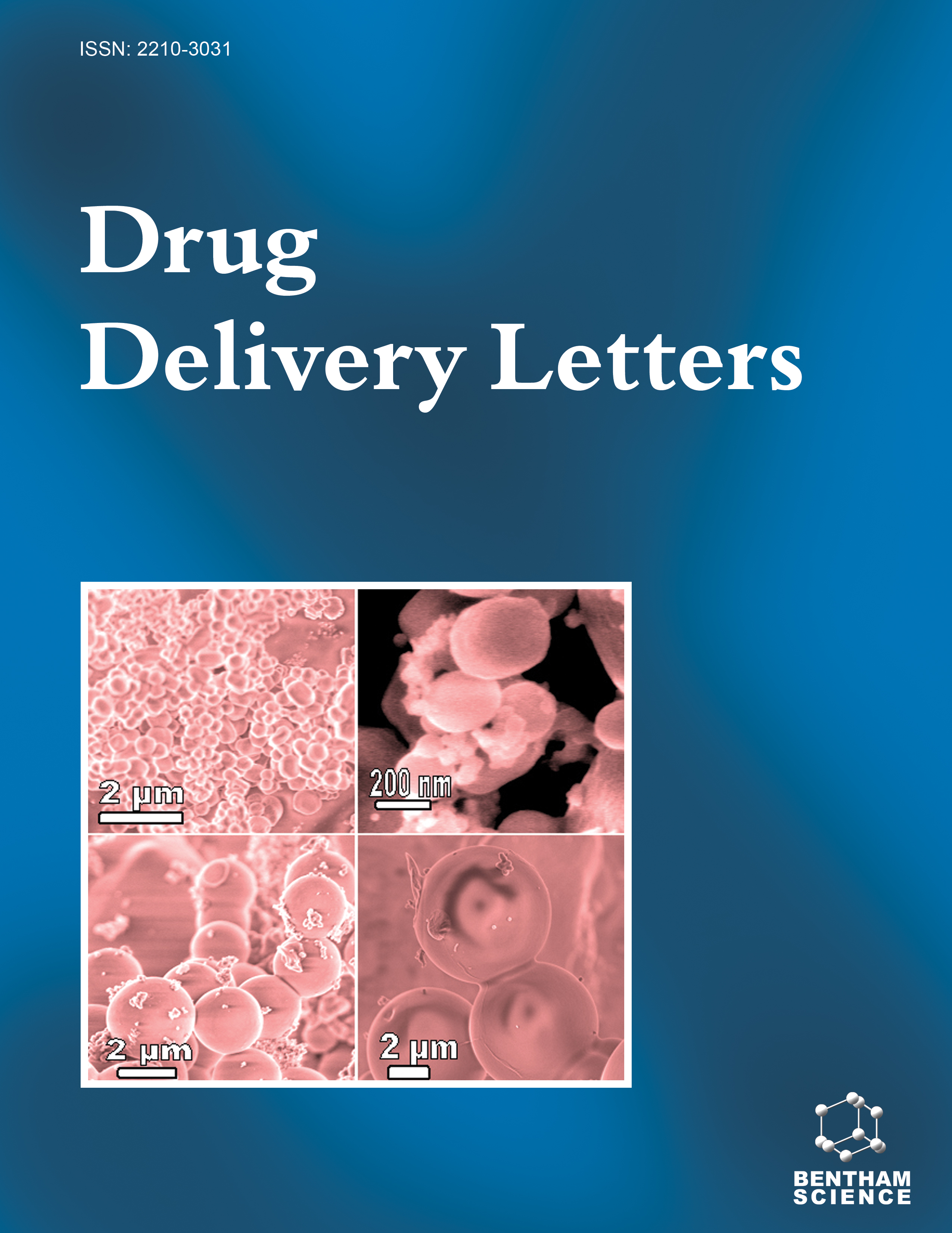- Home
- A-Z Publications
- Drug Delivery Letters
- Previous Issues
- Volume 2, Issue 1, 2012
Drug Delivery Letters - Volume 2, Issue 1, 2012
Volume 2, Issue 1, 2012
-
-
Editorial
More LessBy Istvan TothThe first issue of Drug Delivery Letters for 2012 contains exciting articles with a focus on preclinical research in drug delivery. The effect of various formulation parameters are reported on the properties of hydrogel wound dressings Jadhav et al., and on plasmid DNA/membrane interaction during in vitro gene electrotransfer Escoffre et al., Formulation studies show the tableting properties of assam bora rice starch Ahmad e Read More
-
-
-
Tableting Properties of Assam Bora Rice Starch
More LessStarches are used as fillers, binders, and disintegrating agents in the tablet formulation due to their suitable physicochemical as well as mechanical properties. In the present investigation, a study has been done on the compaction properties of Assam Bora rice starch, and their physicochemical properties are evaluated. Assam Bora rice starch exhibit good flow properties. The influences of physical and geometrical properties of Read More
-
-
-
Effect of Various Formulation Parameters on the Properties of Hydrogel Wound Dressings
More LessAuthors: Harshalkumar Jadhav, Amita Joshi, Manju Misra and Aliasgar ShahiwalaThe work presented in this manuscript was undertaken to evaluate the effect of various formulation parameters on the essential properties of hydrogel wound dressings. PVA and PVP based hydrogel dressing systems were prepared by irradiation cross-linking and freeze thawing method. Prepared hydrogels were characterized for swelling index, water vapor transmission rate (WVTR), mechanical strength, gel fraction and Read More
-
-
-
Immunotherapy in a Rabbit Model of Alzheimer’s Disease
More LessAuthors: Diana S. Woodruff-Pak, Christina Shriver, Alexis Agelan, Joanne M. Manns and Richard CoicoTo investigate immunotherapy in non-rodent model of Alzheimer’s disease (AD), 14 rabbits were fed a cholesterol/ copper regimen for 10 weeks (“hypercholesterolemic” or “AD model rabbits”), and 4 rabbits were fed normally (“control rabbits”). Six or 8 weeks after diet initiation, 10 hypercholesterolemic and 4 control rabbits were injected with conjugated Aβ1-42-peptide mixed with Freund’s complete adjuvant and b Read More
-
-
-
Effect of Electric Field Intensity on Plasmid DNA/Membrane Interaction during In-Vitro Gene Electrotransfer
More LessAuthors: Jean-Michel Escoffre, Elisabeth Bellard, Emilie Phez, Marie-Pierre Rols and Cyril FavardElectropermeabilization is one of the non-viral methods successfully used to transfer genes into living cells invitro and in-vivo. Although this method shows promises in the field of gene therapy, very little is known about the basic processes supporting plasmid DNA transfer. In contrast to small molecules that have direct access to the cytoplasm, plasmid DNA forms a long-lasting complex with the permeabilized membrane. The Read More
-
-
-
Preparation and Evaluation of Vancomycin Microemulsion for Ocular Drug Delivery
More LessAuthors: Rahul Nair, M. Chakrapani and Rajesh KazaThe main objective of the present investigation was to develop and evaluate the potential of microemulsion (ME) for the ocular delivery of Vanocomycin (VM). The solubility of VM in oils and surfactants were checked to identify components of the micro emulsion. The ternary phase diagrams were plotted to identify the area of ME existence. The prepared ME’s were characterized for pH value, refractive index, viscosi Read More
-
-
-
Development of Platform Technology for Oral Controlled Delivery of Highly Water Soluble Drugs Using Milnacipran HCl as a Model Drug
More LessAuthors: Punit B. Parejiya, Bhavesh S. Barot, Hetal K. Patel, Pragna K. Shelat and Arun K. ShuklaThe present study was aimed towards development of porosity controlled osmotic pump as a platform technology for delivering highly water soluble drugs using Milnacipran HCl as a model drug. Theoretical zero order drug release profile (5 mg/hr) was targeted to achieve for fulfilling desired plasma concentration up to 24 hrs. Novel ethyl cellulose based coating system, Aquarius EKX 19102 SRX-2, was employed in the Read More
-
-
-
Influence of Ultrasound Mediated Transdermal Delivery of Losartan Potassium
More LessAuthors: Rao Rekha, Nanda Sanju and Anroop B. NairThe effect of ultrasound energy on transdermal permeation of Losartan Potassium (LP) across albino rat skin was studied in vitro. Experiments were performed using therapeutic ultrasound (1MHz) at different intensities (0.5 and 2.5 W/cm2) for 10 and 30 minutes in continuous and pulsed (1:1) modes. Ultrasound variables used in present investigation were selected on the basis of 23 full factorial design. The flux observed f Read More
-
-
-
Hoffmeister Ion Series Protected Bee Venom Proteins from Damages Induced by Microencapsulation Process
More LessPLGA (poly-lactide-co-glycolide) microspheres have more than 30 years of use in drug delivery, but there are some limitations related to protein stability during the process of microencapsulation. During the W1/O phase (in the W1/O/W2 microencapsulation process), hydrophobic interfaces are expanded where interfacial adsorption occurs followed by protein unfolding and aggregation. These problems have limited their usa Read More
-
-
-
Multidimensional Role of Inulin as Synbiotic, Drug Carrier and Synergistic Adjuvant for the Colonic Delivery of 5-FU
More LessAuthors: V. R. Sinha and HoneyNatural polysaccharides are being extensively manipulated for the colon drug delivery systems. Nowadays, therapeutic compositions are being investigated that can effectively play a versatile role. The present investigation is aimed to design a colon specific microbially triggered system using biodegradable co-polymer mixtures. The prime focus of the study was to design and evaluate a swelling dependent delayed releas Read More
-
-
-
Subdural Pharmacotherapy for the Treatment of Intractable Focal Neocortical Epilepsy
More LessThe Subdural Pharmacotherapy Device (SPD) is an experimental medical implant for the treatment of intractable focal neocortical epilepsy. The device performs spatially and temporally controlled administration of seizurepreventing drugs into the subarachnoid space overlaying the neocortical seizure focus or foci. This is accomplished with the use of a multifunction subdural strip, through which the device periodicall Read More
-
Volumes & issues
Most Read This Month
Article
content/journals/ddl
Journal
10
5
false
en


